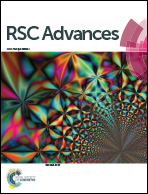Luminescence properties, energy transfer and multisite luminescence of Bi3+/Sm3+/Eu3+-coactivated Ca20Al26Mg3Si3O68 as a potential phosphor for white-light LEDs
Abstract
A series of blue-to-red emitting Ca20Al26Mg3Si3O68:Bi3+/Sm3+/Eu3+ phosphors were synthesized via a high temperature solid-state reaction method. The crystal structure, luminescence properties, energy transfer and multisite luminescence were investigated in detail. Under ultraviolet (UV) light excitation of 343 nm, Bi3+-doped Ca20Al26Mg3Si3O68 phosphors exhibit a broad blue emission band from 370 to 600 nm which is derived from the allowed transition 3P1 → 1S0 of Bi3+ ions. The Ca20Al26Mg3Si3O68:Sm3+ samples show orange-reddish emission bands at 561, 598, 649 and 708 nm under the excitation of 401 nm. The red emission of Ca20Al26Mg3Si3O68:Eu3+ samples at 587, 616, 654 and 700 nm were detected under the excitation of 392 nm, due to 5D0 → 7FK (K = 1, 2, 3, and 4) transitions. In addition, two kinds of sites for cations (Ca2+) in the host were considered from the high resolution site-selective spectroscopy of Ca20Al26Mg3Si3O68:Eu3+ at low temperature, which matches with the crystal structure of Ca20Al26Mg3Si3O68. Meanwhile, in the Bi3+, Sm3+ co-doped Ca20Al26Mg3Si3O68 samples, the energy transfer from Bi3+ to Sm3+ can be found from the photoluminescence spectra and the fluorescence decay curves. The emission hue can be tuned from cool white (0.270, 0.267) to white (0.334, 0.293), and finally to warm white light (0.405, 0.317) by suitably varying the ratio of Bi3+/Sm3+, indicating that the developed phosphor may be potentially used as a single-component white-emitting phosphor for UV light-emitting diodes. The phosphors CAMSO:Bi3+,Eu3+ develop excellent red-emission properties, so that the Eu3+ doped samples have potential application in WLED.


 Please wait while we load your content...
Please wait while we load your content...